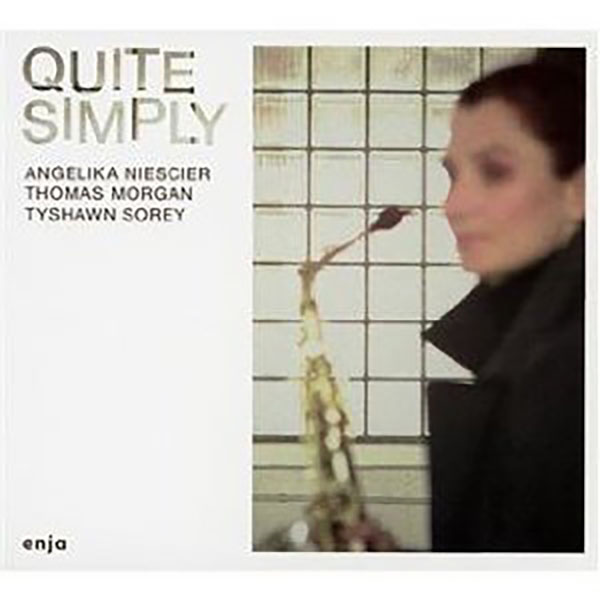
by Tim Owen
December 19, 2011
/ ALBUM
Niescier's trio negotiate a variety of moods but achieve a consistent tone of understated, unforced confidence.
31 year old, Polish-born saxophonist Angelika Niescier has been winning plaudits from the German press for years, but is little known in Britain or America. I think that might change. The recognition gained momentum in 2001 when Niescier formed the modestly named (in German) ?Sublim’ quartet, and in 2004 when that band first toured in Europe. Their second album was, say Enja, heralded by German publication Jazz Thing as the best German jazz recording of the past 10 years. For the follow-up, ?Sublim III’ (2009), Niescier demonstrated adventurousness by adding an oud to the lineup for the 20 minutes of the two part “Oud Suite”. And now, on ?Quite Simply’, Niescier essays something different again; a back-to-basics trio with two new musical partners; and I think she’s on to something special.
Bassist Thomas Morgan has played with such artists as Joey Baron, David Binney, Steve Coleman, and Sylvie Courvoisier. In 2012 he will play European dates alongside Gerry Hemingway in trombonist Samuel Blaser’s band, Consort in Motion. Tyshawn Sorey has also played with Blaser. He studied with Anthony Braxton at Wesleyan University, so naturally he cites Braxton associate Gerry Hemingway as a role model (http://bit.ly/29MjYz). The drummer has two CDs under his own name: That/Not (2007) and Koan (2009). He is a member of Steve Coleman’s Five Elements, and plays in the Fieldwork trio alongside Vijay Iyer and Steve Lehman, as well in a trio led by saxophonist Ingrid Laubrock.
Full playback of ?Quite Simply’ lasts a clean, lean 68 minutes, over which the trio negotiate a variety of moods but achieve a consistent tone of understated, unforced confidence. Compositions by Ornette Coleman and Anthony Braxton complement six originals by Niescier.
“Diffractions” is a bright, up-tempo lead track?the first of three that extend to ten minutes?which practically scuttles along. Niescier’s sax is lean and agile as she explores increasingly impressionistic thematic variations. Sorey essays a carefully shaded solo for a good portion of the track’s second half, without once threatening self-indulgence. Echoes of cymbal scrape and spartan bass plucks announce “Mithra’s Despair”, as Niescier does little more than withhold her breath. The track gradually firms up, but its rhythm remains stately, even borderline funereal, as Niescier unfurls an absorbingly reflective solo.
Ornette Coleman’s “Congeniality” will be instantly recognisable, in all its jaunty individuality, to anyone who knows Coleman’s classic ?Shape of Jazz to Come’ album. But the trio hold the theme at a slight distance, addressing it by turns lightly, directly, and in abstraction. Niescier is discursive in opening it up, while Morgan and Sorey fillet the composition of its rhythmic possibilities. A sinewy “Level 3” prompts Niescier to push into harsher registers. In its second half she locks onto a repeated motif as the rhythm section improvise a dynamic backdrop. The bass gives shape to the track as it builds to a crescendo of accumulated pressure modulated by Storey’s drumming.
“Uncertainity Principle” is a ballad, and a lovely example of the trio working in counterpoint. The sax lays down a narrative to percussion counterpoint, guided by the bass. Storey provides a commentary on Niescier’s lines, firming up the dynamics when her long, meditative solo threatens to lapse into solipsism. This rather bookish introspection is maintained for “69-0”, the Braxton composition (documented by Braxton on his mammoth ?Willisau (Quartet) 1991’ album). This is one of Braxton’s ?story’ compositions, which (from memory) he visualises as a series of interlinked rooms. Its initial tentativeness cedes to something brooding but alert, shaped by rippling toms and burred bowed bass. The sax is at first stately, but becomes tremulous, so a sudden up-tempo recapitulation of the theme before the next track snaps into focus comes as something of a surprise.
The lively pulse of “Untitled” is pretty welcome after the fifteen down-tempo minutes of “Uncertainty” and “69-0”. Its theme is briefly but lyrically rendered by Niescier. The track eases back but never loses its momentum, as Storey inventively maintains an impressive work rate. He pushes the saxophonist’s fiery eloquence to some passionate declamations, but its the bass that then dictates the discourse in a midway ease-off. A snap back to the now naggingly familiar theme suggests that the track has the makings of a firm live favourite. As the final piece, “Bajazzo” slowly opens up Thomas’ bass provides a mournful, low-key backing for a reflective sax solo. But the trio guide the album out in mostly insouciant style, and the ending flirts bravely with introversion. It’s as if the trio realise they have little more to prove, and little to gain by unwanted grandstanding.
This has been one of my surprise finds of 2011. It should appeal to anyone who likes Anthony Braxton’s jazzy small-group recordings of the late 80s, but has the potential to reach a broader demographic, from Late Junction’s audience, say, to lovers of the most adventurous contemporary improv.
blog comments powered by Disqus